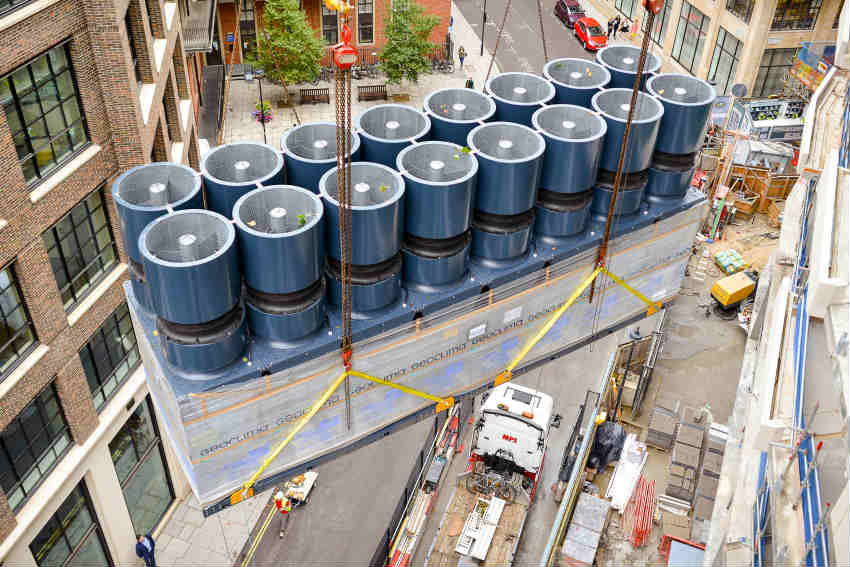13 February 2017
|
When developers demanded very low sound limits for two new apartment building in London, Cool-Therm worked with contractors to come up with the answer.
Cool-Therm has supplied an ultra-low sound, high efficiency 1.8MW air conditioning solution for a prestigious development of luxury apartments in London’s Westminster.
Cool-Therm has supplied an ultra-low sound, high efficiency 1.8MW air conditioning solution for a prestigious development of luxury apartments in London’s Westminster.
| | The development, by Berkeley Group, includes a gym, pool, sauna facilities and business suite. To meet high sustainability standards, the buildings are designed to achieve Level 4 of the Code for Sustainable Homes, the national UK standard for sustainable new homes. Outstanding energy efficiency is achieved through the use of a Combined Heat and Power (CHP) system, heat recovery ventilation, high levels of insulation and airtightness, and use of LED lighting. High efficiency air conditioning is provided by two custom-designed Turbomiser chillers, selected for their low carbon cooling and exceptionally quiet operation in a new and unique configuration. Restricted space The two buildings, Abell House and Cleland House, are located opposite one another on John Islip Street, in central London. The air conditioning plant is located in Cleland House, serving both buildings via pipework in a service tunnel under the main road. The specification for the project required very low sound limits, due to its luxury residential nature. Air conditioning plant also had to be accommodated in restricted space, in order to maximise floor space for occupation. Cool-Therm worked closely with M&E contractor Briggs and Forrester on a new design for the Turbomiser chillers to achieve the space and sound objectives. To reduce the chiller footprint, all associated plant is accommodated on a structural frame beneath the chiller, containing isolation valves, trace heating, sequence controls, cable tray, controls, BMS interface and connecting pipework. Steve Soffe, Cool-Therm’s southern area manager, said: “The initial proposal was for a screw-based chiller solution with cooling towers. However, Briggs and Forrester worked with Berkeley to propose an alternative design using fully packaged Turbomiser chillers, which freed up space for additional residential capacity, as well as delivering excellent sound and efficiency. These were major pluses and highly attractive for the developer.” The sound specification for the project, by consultant AECOM, required a challenging limit of 51dBA at 10m. The original Turbomiser chillers in standard format were rated at 63dBA at 10m. Achieving the 12dBA reduction required re-engineering the conventional Turbomiser design. Reduced turbulence Three additional sound attenuation measures were applied to the already low noise Turbocor-based chiller. The most substantial and visually striking is the addition of acoustic attenuation towers to both sides of each condenser fan, making an upper array of 16 towers per chiller. Measuring 1.6m high and around 1m in diameter, each acoustic tower is lined with lead damping material and a perforated liner to absorb sound. Unusually, the condenser fan is positioned at the mid-point within the tower, providing attenuation at both air inlet and discharge sides. A bull-nosed column in the tower further reduces turbulence, while the fans themselves are sickle-bladed low noise units, which help to streamline airflow and again reduce sound. The Turbocor compressors are housed in acoustic enclosures, reducing sound from this source by some 6-7dBA. Finally, refrigerant discharge lines from compressors to condenser are lined with lead insulation, reducing vibration and noise further. Rob Young, Cool-Therm director, said: “The design takes a multi-element approach to both saving space and reducing sound. Our calculations were that it would achieve the required 51dBA at 10m, and this was confirmed in performance tests at Geoclima’s laboratory, with representatives of the contractor and consultant in attendance.” Demanding requirements David Gilbert, MEP manager, Berkeley Homes Central London, said: “The demanding requirements of the project required a collaborative and team approach. The solution meets the brief in terms of efficiency, space constraints and sound characteristics, as well as delivering the required comfort conditions for building occupants.” Following experience gained in the project, Cool-Therm is now developing an ultra-low noise version of the Turbomiser chiller available as a standard option. Equipped with a suite of sound attenuation technologies, it will offer what is claimed to be the lowest sound output for any commercially chiller on the market. Equipped with this Hush Technology®, the new ultra-quiet Turbomiser is ideally suited for use in applications that require very low sound levels, such as premium city centre residential applications, hospitals, libraries and universities. |
Content continues after advertisements











